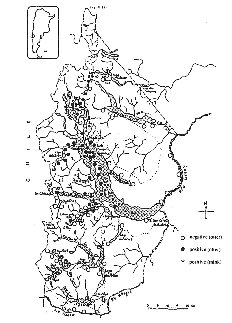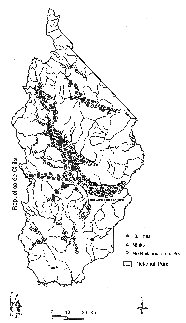 |
Last Update:
Thursday November 22, 2018
|
| [Home] |
The Southern River Otter or huillín has a very restricted natural distribution (a narrow fringe in the south of Argentina and Chile). Between February and May 1995 we made a sign-survey of this species in Nahuel Huapi National Park, in the northern portion of the Patagonian Andes of Argentina. Twelve years after the first survey (1982/83,
Fig 1
), our aim was to monitor the distributional and relative abundance status of this important population, and in particular to evaluate its response to some changes which occured in its habitat in the last decade. Over a total of 216 sites visited, we found otter signs in 78 (36.11%) (28% in 1982/83). Similarly to the first survey, all the positive sites are in the Limay River basin, where they are 45,08% of the total (39,44% in 1982/83). We found signs of introduced North-American mink (Mustela vison) in 126 sites (58.33%) in all basins. Since the first survey mink (which were at that time restricted to the southernmost portion of the park) occupied the whole park, but we did not find any evidence of a negative impact upon distribution and abundance of huillin. This survey confirmed one of the main conclusions of the first one: the large basin which includes Nahuel Huapi National Park is a key place for the conservation of this species in the National Park, and due to its large size it seems to hold a viable population. These preliminary results indicate that this population is in a stable and satisfactory conservation status, at least within the time framework of the last decade. One potential threat is the probable isolation of the population. This aspect, difficult and costly to evaluate, will have to be addressed in the future. We make some recommendations:
|
| [Copyright © 2006 - 2050 IUCN/SSC OSG] | [Home] | [Contact Us] |

